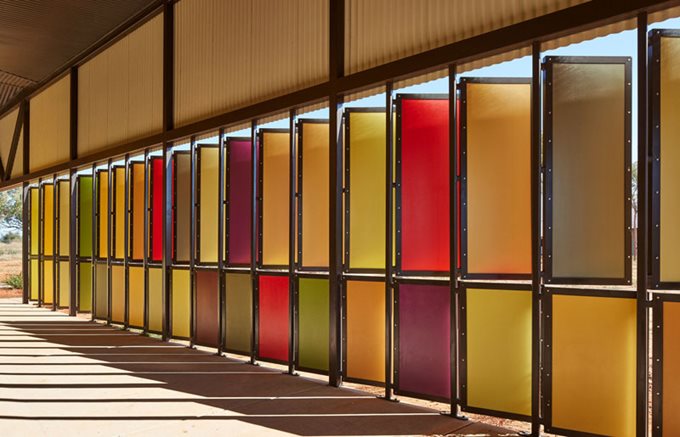

Cultural sustainability in a colourful outback gem
Fitzroy Crossing Renal Hostel is a final home for people with end-stage Renal Disease, where they can stay close to their family and community while receiving treatment.

Fitzroy Crossing Renal Hostel is a final home for people with end-stage Renal Disease, where they can stay close to their family and community while receiving treatment.
Patients with end-stage Renal Disease need to receive Hemodialysis for 2.5 – 4.5 hours, three times per week. Before the establishment of this accommodation facility and the associated “Renal Chairs” in the nearby hospital, people had the option of moving 2,500km to Perth or staying in their community and dying. Faced with these choices, many people were choosing to forgo treatment to stay in their community.
Design

The facility includes 13 rooms for residents, which are divides among six small “houses” that can each accommodate 19 people.

Each room contains one or two bedrooms, with a wheelchair accessible ensuite, tea preparation bench and insect-screened verandah.
Houses include a front porch that allows for public engagement, while the rear verandah offers a more private space.
The design includes a number of culturally sustainable design features:
- The allowance of “cultural surveillance” – the need for Aboriginal people to observe the movement of people through the landscape
- Multiple paths of travel to support “avoidance” relationships
- View corridors into the landscape
- Language-specific landscape species selection
- Support for outdoor cooking and fire use
- Addressing mortuary practices
The facility includes an amenity building which provides access control, kitchen, staff and community laundry facilities, communal dining and activity spaces, offices and meeting rooms, as well as two staff accommodation units.
As many of the facility’s residents are Elders in their community, the amenity building serves as a place of dignity for them to interact with their family.
Materials

The building consists of a concrete slab on the ground, with steel frames, Colorbond steel and painted fibre cement cladding. These materials have been shaped to resemble the forms of a cottage or a civic building. Their simple forms have been articulated by a soaring roof which reduces radiant heat loads to capture cooling winds.
Key products/suppliers:



